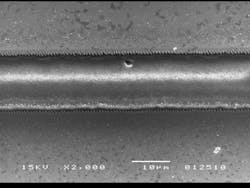Ultrafast laser scribing works well for thin-film solar cells
West Lafayette, IN--Researchers at Purdue University are studying the use of a picosecond laser to scribe thin-film solar cells via cold ablation, testing on films of molybdenum and zinc oxide. After scribing these films, they measured the slot profiles with a surface profilometer and a scanning electron microscope, finding 0.1 micron accuracy, sharp edges, and a flat bottom.
The innovation may help to overcome two major obstacles that hinder widespread adoption of solar cells: high manufacturing costs and low efficiency, according to Yung Shin, a professor of mechanical engineering and director of Purdue University's Center for Laser-Based Manufacturing.
Critical to both are the microchannels needed to interconnect a series of solar panels into an array capable of generating useable amounts of power, he said. Conventional scribing methods, which create the channels mechanically with a stylus, are slow and expensive and produce imperfect channels, impeding solar cells' performance.
"Although laser scribing has been studied extensively, until now we haven't been able to precisely control lasers to accurately create the microchannels to the exacting specifications required," Shin said.
A research paper demonstrating the feasibility of the technique was published in Proceedings of the 2011 NSF Engineering Research and Innovation Conference in January.
Subscribe now to Laser Focus World magazine; it’s free!

John Wallace | Senior Technical Editor (1998-2022)
John Wallace was with Laser Focus World for nearly 25 years, retiring in late June 2022. He obtained a bachelor's degree in mechanical engineering and physics at Rutgers University and a master's in optical engineering at the University of Rochester. Before becoming an editor, John worked as an engineer at RCA, Exxon, Eastman Kodak, and GCA Corporation.
